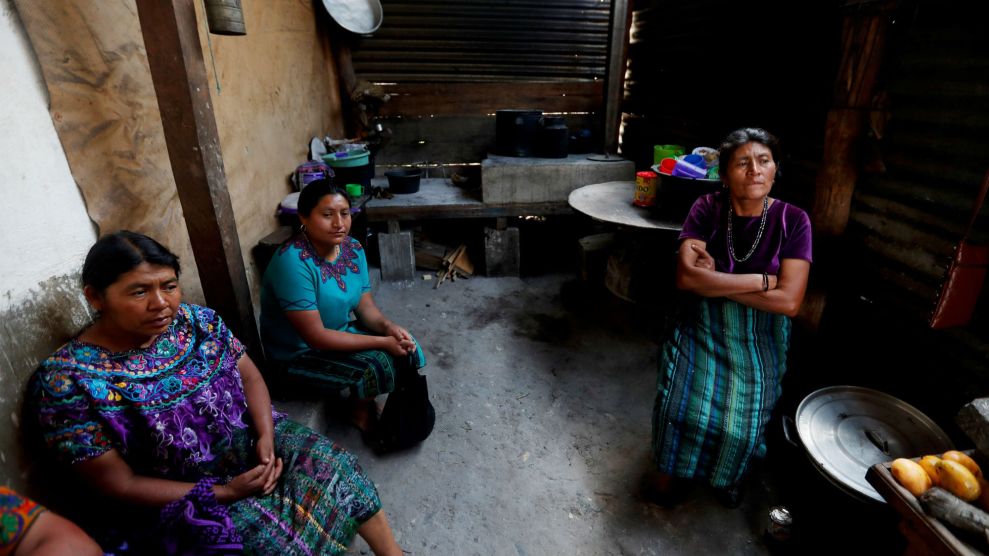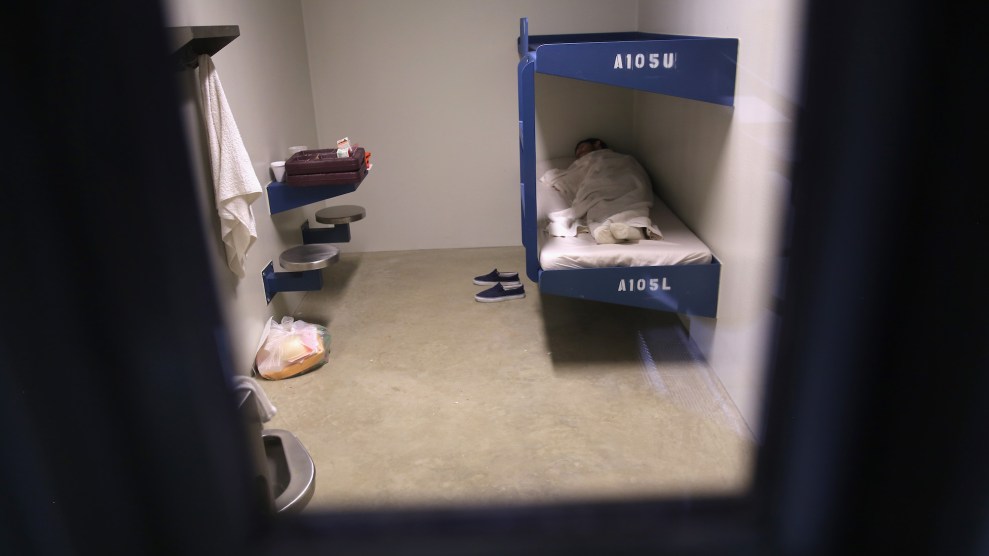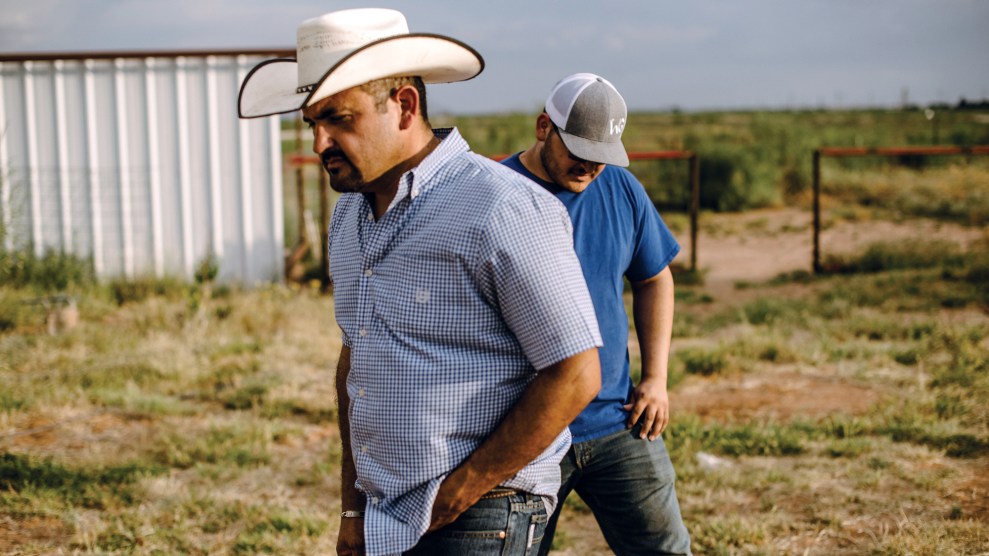
Rigoberta Vasquez, mother of 16-year-old Carlos Gregorio Hernandez Vasquez, who died at a Texas Border Patrol station, waits for news of the repatriation of her son's body in Guatemala.Esteban Biba/ZUMA Press
This story was published in partnership with ProPublica, a nonprofit newsroom that investigates abuses of power. Sign up for ProPublica’s Big Story newsletter to receive stories like this one in your inbox as soon as they are published.
Carlos Gregorio Hernandez Vasquez, a 16-year-old Guatemalan migrant, was seriously ill when immigration agents put him in a small South Texas holding cell with another sick boy on the afternoon of May 19.
A few hours earlier, a nurse practitioner at the Border Patrol’s dangerously overcrowded processing center in McAllen had diagnosed him with the flu and measured his fever at 103 degrees. She said that he should be checked again in two hours and taken to the emergency room if his condition worsened.
None of that happened. Worried that Carlos might infect other migrants in the teeming McAllen facility, officials moved him to a cell for quarantine at a Border Patrol station in nearby Weslaco.
By the next morning, he was dead.
In a press release that day, Customs and Border Protection’s acting commissioner at the time, John Sanders, called Carlos’ death a “tragic loss.” The agency said that an agent had found Carlos “unresponsive” after checking in on him. Sanders said the Border Patrol was “committed to the health, safety and humane treatment of those in our custody.”
But the record shows that the Border Patrol fell far short of that standard with Carlos. ProPublica has obtained video that documents the 16-year-old’s last hours, and it shows that Border Patrol agents and health care workers at the Weslaco holding facility missed increasingly obvious signs that his condition was perilous.
The cellblock video shows Carlos writhing for at least 25 minutes on the floor and a concrete bench. It shows him staggering to the toilet and collapsing on the floor, where he remained in the same position for the next four and a half hours.
According to a “subject activity log” maintained by the Border Patrol throughout Carlos’ custody, an agent checked on him three times during the early morning hours in which he slipped from unconsciousness to death, but reported nothing alarming about the boy.
The video shows the only way CBP officials could have missed Carlos’ crisis is that they weren’t looking. His agony was apparent, even in grainy black and white, making clear the agent charged with monitoring him failed to perform adequate checks, if he even checked at all. The coroner who performed an autopsy on Carlos said she was told the agent occasionally looked into the cell through the window.
The video makes clear that CBP, the Border Patrol’s parent agency, inaccurately described how Carlos’ body was discovered. Contrary to the agency’s press release, it was Carlos’ cellmate who found him, not agents doing an early morning check. On the video, the cellmate can be seen waking up and groggily walking to the toilet, where Carlos was lying in a pool of blood on the floor. He gestures for help at the cell door. Only then do agents enter the cell and discover that Carlos had died during the night.
Officials with the Department of Homeland Security, which includes CBP, wouldn’t say whether the scenes recorded by the camera during Carlos’ final hours were shown live on video monitors, as is the case in some Border Patrol facilities, and if they were, whether anyone had been assigned to watch the footage.
The video and other records reviewed by ProPublica document numerous missteps in the days leading up to Carlos’ final hours on the floor of Cell 199. Independent medical experts pointed in particular to the decision to send a 16-year-old suffering from the flu to a holding cell rather than a hospital as a pivotal mistake.
“Why is a teenaged boy in a jail facility at all if he is sick with a transmissible illness? Why isn’t he at a hospital or at a home or clinic where he can get a warm bed, fluids, supervised attention and medical care? He is not a criminal,” said Dr. Judy Melinek, a San Francisco-based forensic pathologist who reviewed records of Carlos’ death at the request of ProPublica. “No one should die this way: vomiting, with a fever and without the comfort of a caregiver.”
A CBP spokesman declined to respond to a series of questions about Carlos’ death, citing an ongoing internal investigation. “While we cannot discuss specific information or details of this investigation, we can tell you that the Department of Homeland Security and this agency are looking into all aspects of this case to ensure all procedures were followed,” CBP spokesperson Matt Leas said.
CBP has refused to release the video and other records of Carlos’ death to the public or Congress, citing the ongoing internal investigation. But using Texas open records laws, ProPublica obtained material from the Weslaco Police Department, which briefly investigated his death. The records included surveillance video, detainee logs and health records turned over to police by Border Patrol.
Interviews and documents illustrate how immigration and child welfare agencies, while grappling with surging migrant numbers, were unable to meet their own guidelines for processing and caring for children. With holding tanks that were never equipped to house migrants for more than a few hours, the Border Patrol was inundated with families and children. Shelters for children, offering beds and medical care, were already packed.
The agency held Carlos for six days, though the agency is supposed to transfer children within 72 hours.
Carlos was the sixth migrant child to die after being detained while entering the U.S. in less than a year. Some died of preexisting illnesses, but at least two others died of the flu diagnosed while in Border Patrol custody. Carlos was the only one to die at a Border Patrol station; the others were taken to medical facilities after falling ill. In the previous decade, not a single migrant child had died in custody.
Carlos’ death prompted changes to require Border Patrol agents to enter the cells of ailing detainees at regular intervals to check on them and take temperatures, according to a source familiar with the fallout.
The DHS inspector general has been investigating the circumstances of Carlos’ death but has not released any findings.
Sanders, the acting head of the agency, resigned soon after the incident. He recently faulted unprepared agencies and an unresponsive Congress for a tragedy that he said was both predictable and preventable.
The deaths of Carlos and other children under his watch continue to haunt him. “I believe the U.S. government could have done more,” he said.
Carlos’ Journey
Carlos left his remote village in central Guatemala in early May. San Jose del Rodeo, home to indigenous Maya, is set in a lush landscape, and the village is a collection of tin-roofed houses and smoky outdoor cooking fires. The valleys below provide most of what little work there is, on farms growing and harvesting corn, coffee beans and sugar cane.
Carlos, the second youngest of eight children, was a standout student at the village school. He was captain of the soccer team and excelled in playing instruments the school had bought by selling raffle tickets. “He played percussion and the bombo and the lyre and the trumpet,” said Jose Morales Pereira, who was Carlos’ teacher. “He always said, ‘Professor, let’s teach everyone else.’ He was my leader.”
Bartoleme Hernandez, Carlos’ father, worked when he could planting corn or clearing land. He wore cut up tires on his feet to save his shoes for Sundays. Money was so tight that Carlos sometimes came to school with no lunch and did weekend farm work and odd jobs to help out, his teacher said.
As children, Carlos and his friends made a game of pretending to cross the border. To reach their imaginary U.S., they scaled a fence, and Carlos always played the one who made it across. The kids used guava leaves as pretend money to send to family back home, recalled a childhood friend who described the game in a Facebook post.
Two dozen or more young friends had traveled to the U.S. before Carlos. Crossing the border typically cost migrants $5,000 to $10,000 for smugglers who offer safe passage through drug cartel territory. Some migrants take out loans to fund their travel; Carlos told his teacher he might work along the way to pay his fees. He had a brother already in the U.S., and he planned to find a construction job.
Starting late last year, smugglers ran express buses up through Mexico to meet demand. A family member said Carlos and his sister traveled by bus for much of their journey. At the Rio Grande on May 13, they wore life vests and crowded onto a rubber raft with a half-dozen others.
Their parents received a video that day—later shared with the media—showing them casting off into the river. The siblings landed near Hidalgo at the southern tip of Texas, part of a group of 70 that was immediately rounded up by border agents.
In custody, Carlos was separated from his adult sister, as required under the law. He was assigned an alien identification number—A203665141—to help agencies track him. A Border Patrol agent at the warehouselike processing center in McAllen screened Carlos for illness or injury and found none.
Migrants were supposed to be held in CBP centers for no more than three days before being deported, moved to Immigration and Customs Enforcement detention centers or released pending a hearing. Under a 2008 anti-trafficking law, children and teenagers crossing the border illegally without parents or guardian generally must be placed with the Office of Refugee Resettlement at the Department of Health and Human Services within 72 hours, except in the case of heavy influx. Then they must be moved out as quickly as possible.
But Carlos had arrived at the peak of the surge, with 144,000 migrants apprehended in May alone. With the overflow crowds, nothing was working as it should have been. HHS and Immigration and Customs Enforcement were backlogged in transferring children out of CBP custody. In a spot check soon after Carlos died, the DHS inspector general reported that a third of the 2,800 unaccompanied minors in CBP custody in the Rio Grande Valley had been there longer than 72 hours.
Authorities at first questioned whether Carlos was a minor and whether the woman he was traveling with was his sister, according to a CBP source with knowledge of the matter. It took agents 48 hours to determine he was a few weeks shy of his 17th birthday, and the confusion delayed the search for HHS shelter space.
The McAllen facility where Carlos arrived on May 13 was barely fit for habitation. The DHS inspector general visited Rio Grande Valley Border Patrol facilities about a month later, as the number of apprehensions had begun to decline, and found holding pens packed well beyond capacity and other appalling conditions. The inspector general’s urgent alert to management warned that the overcrowding posed “an immediate risk to the health and safety” of both agents and detainees, including through the spread of infectious diseases.
Border Patrol centers were designed to temporarily hold migrants and were not set up for long-term detention, which typically includes medical staff to treat detainees who become ill. The agency had a handful of emergency medical technicians assigned to the centers. In late 2018, it had only 20 medical staffers working under contract along the 2,000-mile Mexican border to monitor the health needs of 50,000 apprehended migrants a month. CBP brought in medics from the Coast Guard and other federal agencies after two children died in custody in December and as the number of border crossers in custody began to approach 100,000 a month.
At the high point of the migrant surge in May, the Border Patrol had custody of 20,000 people a day; its definition of a crisis is 6,000 detainees.
As the surge escalated and Sanders and others pressed for help, the DHS shifted $47 million for additional medical staff to its contract provider, Loyal Source Government Services. (The company did not respond to requests for comment.)
Loyal Source increased its hiring, running a stream of job ads like one seeking EMTs for screenings at the Weslaco Border Patrol station, where Carlos died, that offered full-time, part-time, day, night and weekend shifts.
The prospect of flu outbreaks was a growing concern. The CBP had rejected a recommendation from the Centers for Disease Control and Prevention that it vaccinate migrants, saying such a program was impractical and complex. Amid the crowding, Border Patrol agents, trained in law enforcement, had reluctantly stepped into care-taking roles.
If Carlos had made it to an HHS shelter, he likely would have been vaccinated for the flu, a standard procedure in HHS shelters. But when HHS finally found a bed for him, the agency postponed his relocation because he had the flu and was not fit to travel.
Carlos had been detained in McAllen for six days when he reported feeling ill.
At 1 a.m. on May 19, he saw a nurse practitioner and complained of a headache and fever. Tests showed he had type A flu and a 103-degree fever. Nurse practitioner Irasema Gonzalez gave him ibuprofen and Tylenol and ordered Tamiflu, which is a standard treatment for flu symptoms.
Gonzalez’s treatment report also said Carlos should “return to medical office in 2 hrs or sooner” and should be taken to an emergency room if his symptoms persisted or worsened. There is no record of further medical treatment over the next 19 hours in the records obtained by ProPublica. Gonzalez didn’t respond to an inquiry from ProPublica.
Carlos was not sent to an emergency room or other outside medical facility. Dr. Joshua Sharfstein, the vice dean for public health practice and community engagement at the Johns Hopkins Bloomberg School of Public Health, said basic monitoring of Carlos should have provided warnings that he was becoming seriously ill.
“Flu can progress rapidly, but it’s not like a heart attack. Even when fast, it worsens over a period of hours. There should have been signs that indicated he needed to go to the hospital,” Sharfstein said.
Instead, records show he was moved at midday to the smaller Weslaco station, where he could be isolated with other sick detainees.
At 8 p.m. that night, Carlos was given Tamiflu at the Weslaco station by Martha Garcia, a nurse practitioner. Her treatment report didn’t record a temperature or vital signs, leaving it unclear how thoroughly he had been examined. The report said Carlos had no medical complaints and was “in no acute distress.” Garcia didn’t respond to an inquiry from ProPublica.
The Border Patrol’s “subject activity log” from early morning on May 20 shows that Carlos was given a hot meal just after midnight. It is unclear if he was able to keep down any food. Weslaco police reports say that was the last time Border Patrol agents saw him alive.
The video of Cell 199 provided to ProPublica by Weslaco police is split into two parts, the first showing more than 33 minutes beginning about 1:13 a.m. and the second showing 1 hour and 11 minutes beginning about 5:48 a.m. Weslaco Police Chief Joel Rivera said that’s how Border Patrol provided the video to his investigators. The investigation ended after the coroner and police found no foul play in Carlos’ death.
CBP didn’t respond to questions about why the tape it provided has a four-hour gap that includes the hours when an agent reported doing welfare checks.
The time stamp on the video is inaccurate, but ProPublica was able to compare it with police and emergency medical service records to estimate that the first video begins at about 1:13 a.m., about an hour after Carlos was fed.
The beginning of the video shows Carlos on the toilet in the cell, partially obscured by a waist-high privacy wall. His cellmate, another ill boy who has not been identified, is asleep under Mylar blankets on a cement bench.
Carlos returns to the cement bench opposite his cellmate about six minutes into the video and shifts uncomfortably. He moves out of the camera’s view for a couple of minutes, apparently sitting or standing next to the cell’s large window.
At about 1:24 a.m., Carlos topples forward and lands face-first on the concrete floor. He is wearing blue jeans and a disposable surgical mask. For the next 11 minutes, he is largely still. At about 1:35 a.m., he vomits blood on the floor and then stands and staggers to the toilet.
The tape shows him sitting on the toilet for about a minute before he slides onto the ground. He struggles for several more minutes and then stops moving at approximately 1:39 a.m. Police photos taken after his death show a large pool of blood around his head.
The second part of the video opens at about 5:48 a.m. Carlos can be seen in the same position as he was four hours earlier. He is on his back, his head by the toilet, and his legs stretching out before him, toes up. The Border Patrol’s log documenting Carlos’ detention for the evening notes three welfare checks during the gap in the video, at 2:02 a.m., 4:09 a.m. and 5:05 a.m. All three log entries were attributed to Agent Oscar Garza.
Garza couldn’t be reached for comment and CBP officials wouldn’t answer questions about the extent of the welfare checks. The pathologist who performed the autopsy, Dr. Norma Jean Farley, said in an interview that she had been told the agent looked through the window but didn’t go inside Cell 199. She said it wouldn’t be unusual for a feverish child to seek comfort by laying on a cool floor.
The CBP’s policies on holding detained migrants are outlined in its National Standards on Transport, Escort, Detention and Search, known as TEDS. The standards are vague about welfare check requirements, saying agents should physically check holding cells in a “regular and frequent manner, according to each operational office’s policies and procedures. Physical inspections must be recorded in the appropriate electronic system(s) of record as soon as practicable.”
At about 6:05 a.m., the tape shows, Carlos’ cellmate awakens and discovers him on the floor. After about a minute, he walks over to the cell door and gets the attention of a Border Patrol agent, identified in police reports as Edgar Reyes.
The agent comes in, shines a flashlight on Carlos’ body and leaves. A few minutes later, a physician assistant, Alda Martinez, comes into the cell with a medic’s kit and attempts one chest compression. She quickly concluded that Carlos was dead, police reports said. Other agents walk in, stepping on silver blankets strewn around the cell. Weslaco paramedics arrive at 6:47 a.m. and declare Carlos dead.
The Border Patrol press release describing these events said “He was found un-responsive this morning during a welfare check.”
The autopsy report did not address how long Carlos had been dead before his cellmate found him. His body had already begun to stiffen when Martinez attempted to revive him. The process of rigor mortis can be accelerated by the flu.
John Sanders had seen the crisis on the border coming as early as November 2018. Then serving as the CBP’s chief operating officer, he had worked the numbers and realized that if projections about the migrant influx held true, agencies would be woefully short of shelter space for unaccompanied minors. An interagency task force monitoring the weather conditions and movements of people in Central America projected huge migrations in the coming months.
But the Trump administration agencies responsible for handling migrants, CBP and HHS, were at odds over the problem’s severity. HHS shelters were then boarding about 15,000 children, but the HHS leadership believed beds would empty out quickly thanks to a policy change reluctantly implemented by Immigration and Customs Enforcement after a long battle. ICE had made it less legally risky for migrant adults to come forward to pick up children in shelters by easing mandatory fingerprinting requirement implemented in April 2018. The December 2018 policy change had increased the number of children released from HHS custody.
Still the numbers kept growing. Buses and car caravans ferried groups of 100 or more migrants at a time to the border; 111 such groups arrived in the winter and spring, compared with 13 the previous year and just two in 2017. CBP told Congress the large groups overwhelmed border security and at the same time created diversions for drug smuggling.
The Trump administration asked Congress in January for $800 million to upgrade border facilities, but it approved about $414 million, including money for a new El Paso processing center to hold children and families, renovation funds for the McAllen processing center and about $192 million for “improved medical care, transportation, and consumables” for those in CBP custody, according to the joint statement issued when the bill was finalized. It soon became clear it wasn’t enough.
Sanders was among the administration officials who appealed to Congress for additional funding. He predicted that without more funding, children would not be safe.
Rep. Lucille Roybal-Allard, a California Democrat who chairs the Homeland Security Appropriations Subcommittee, blamed the Trump administration for conditions that led to the deaths of Carlos and other children.
“Their deaths should never, ever have happened. Tragically, DHS was irresponsible in not having an adequate mass migration plan to keep migrants safe, ensure their humane treatment and address their health care needs,” Roybal-Allard said. She also criticized HHS for failing to have “a plan to ensure it could quickly and safely take custody of unaccompanied children in CBP custody.”
In April, with the border crisis deepening daily, Sanders was named acting CBP commissioner as his boss Kevin McAleenan moved up to become acting secretary of DHS. Those would prove just interim personnel shuffles by a White House determined to harden its border policies.
The fight for money became one of Sanders’ top priorities. By May, as Carlos prepared to head north, the Trump administration made the case for $4.5 billion in emergency aid, with $2.9 billion to cover a shortfall in the program for unaccompanied minors. Democrats supported the humanitarian funding but many objected to $1.1 billion for additional immigrant detention spending.
Carlos’ death highlighted the need for relief. White House acting chief of staff Mick Mulvaney and McAleenan, making the case for the administration’s border funding request, described deteriorating conditions in a May 30 call with reporters:
“Four hundred children arrived in the last 24 hours alone. Four of those children this month have died transiting through Mexico into the United States—two drowning in a river, both a 5-year-old and 10-month-old; and two teenage boys died of infections after receiving medical treatment in federal custody,” McAleenan said. “Yesterday, a single group of 1,036 families and unaccompanied children simply walked from Juárez, Mexico, into the United States illegally as a single group—the largest group ever apprehended at the border.”
Another month would pass before a majority in Congress agreed on the humanitarian funding.
A police investigation into Carlos’ death began soon after his body was discovered, the case assigned to Det. Chris Ramirez of the Weslaco Police Department. There was no sign of foul play, and Ramirez noted that Carlos showed signs of a flulike illness. The Border Patrol turned over its surveillance video for review by police and the forensic pathologist who conducted the autopsy.
Dr. Norma Jean Farley served under contract with the county government. Her work on Carlos’ case included reviewing the timeline presented in the cell video and examining photos of his body from the death scene. Her autopsy report listed the cause of death as Influenza A 2009 H1N1 respiratory infection complicated by bronchopneumonia, sepsis and an immune system disorder called hemophagocytosis.
Farley said in an interview that the video showed that no one entered Carlos’ cell between 12:20 a.m., when he was fed, and around 6 a.m., when the cellmate knocked on the door to get an agent’s attention.
Farley largely defended the Border Patrol’s handling of the matter and questioned why Carlos did not do more to save himself.
“I was a little surprised that this kid, as sick as he was in the cell, never just knocked on the door as his roommate did, because as soon as the roommate did, they opened,” Farley said. “I just don’t know why he didn’t knock on the door.”
H1N1 flu has a typical incubation period of one to four days after exposure, and Carlos was in Border Patrol custody during that time. But Farley said she suspects Carlos may have had diarrhea caused by an immune disorder on his journey through Mexico, although there was no evidence of illness in his Border Patrol medical screening record.
“I’m finding what these people that tend to come there, they don’t tell them that they’re sick. And I don’t know if they’re afraid to tell them they’re sick because they’ll be quarantined. I don’t know what the issue is that they don’t. He finally did, but by the time he’s telling them that he’s sick, he’s more sick than he knows,” she said.
Questions remain about why Carlos’ grave condition was not recognized by the nurse practitioners on May 19, or before, or during his hours at Weslaco. An agency spokeswoman said investigators are looking into “all aspects of a case to ensure proper care procedures were followed.”
The Guatemalan government brought Carlos’ body home to his village to wide television news coverage, its embassy calling on the U.S. to conduct a full investigation of his death. Thousands of mourners poured in from around the country to follow behind his casket, which was borne by soccer teammates down a long dirt road to the cemetery.
Pallbearers taped his royal blue No. 9 soccer jersey to the top of his casket as they laid it to rest. “Maybe in all of his life, the 16 years that he was in this life, maybe he didn’t do many things, but he did move us,” said a speaker at his funeral. “He touched hearts.”
Carlos’ grief-stricken parents questioned how their son could have died in U.S. custody. His father, in an interview with Telemundo, wondered: “He left healthy. What happened to him?”
Carlos’ father, Bartolome Hernandez, said in a phone interview he will be glad to have answers from U.S. officials. “They need to take better care of migrants,” he said. “The U.S. isn’t a place where they should be allowing anyone to die like that.”
Pereira, Carlos’ teacher, said that he believes the boy was abandoned in his cell. He had not seen the video but said “If you have an animal that’s sick and you’ve kept it in a room, every little while you’re going to go check on it, see if it has water, whether it’s shivering. That’s with an animal. And this was a human being.”
In the months that have passed, lawyers at the Texas Civil Rights Project, a migrant advocacy group, have been in touch with Carlos’ family and asked the CBP to preserve its records. They say that so far they have received little information about the death investigation.
Meanwhile, in Washington, moderate House Democrats joined Republicans in passing a bipartisan Senate bill sending $4.6 billion aid to the border on June 27. The impasse was broken a day after a heart-rending photograph went viral showing a drowned father and daughter lying face down on the banks of the Rio Grande.
The border situation has changed dramatically since Carlos’ death. CBP now has 250 health staffers at its facilities across the Southwest, but Border Patrol cells have largely emptied out since July. The number of migrants crossing the border has declined sharply. The Trump administration has credited the decrease to more aggressive interdiction efforts by Mexico.
Adults and families crossing the border increasingly have been sent back to Mexico under the administration’s controversial Migrant Protection Protocols program, which sends them to wait in dangerous Mexican border cities while U.S. courts consider their immigration and asylum claims.
The number of unaccompanied migrant children crossing the border was 2,800 in October, a quarter of what it was when Carlos arrived in May. Still, those who work with migrants on the ground say the numbers could swell again, and HHS is building out its shelter capacity from 15,000 beds to 20,000, with emergency influx facilities that can handle thousands more.
Questions about Carlos’ death and whether agencies or individuals could have done more to prevent it have yet to be fully aired. CBP has not said when the DHS inspector general’s review will be completed. Congressional committees that voiced concern about the spate of child deaths have not had access to the Carlos cell videos, pending internal agency reviews.
The death of the 16-year-old, whose Facebook page showed a circle of teenage friends, reverberated beyond the small village of San Jose del Rodeo. Friends posted video of his funeral and a village wake on social media, with emotional tributes to him. Guatemalan immigrants outside New York City held a fundraiser to help support his family, one of the goals Carlos had in coming to the U.S.
John Sanders resigned soon after the incident, frustrated with what he characterized as unprepared agencies and an unresponsive Congress that allowed children in custody to suffer in harsh conditions.
“I really think the American government failed these people. The government failed people like Carlos,” he said. “I was part of that system at a very high level, and Carlos’ death will follow me for the rest of my life.”













